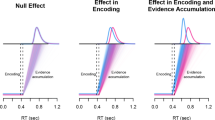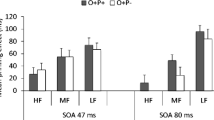Abstract
Masked priming paradigms offer the promise of tapping automatic, strategy-free lexical processing, as evidenced by the lack of expectancy disconfirmation effects, and proportionality effects in semantic priming experiments. But several recent findings suggest the effects may be prelexical. These findings concern nonword priming effects in lexical decision and naming, the effects of mixed-case presentation on nonword priming, and the dependence of priming on the nature of the distractors in lexical decision, suggesting possible strategy effects. The theory underlying each of these effects is discussed, and alternative explanations are developed that do not preclude a lexical basis for masked priming effects.
Similar content being viewed by others
REFERENCES
Andrews, S. (1992). Frequency and neighborhood effects on lexical access: Lexical similarity or orthographic redundancy? Journal of Experimental Psychology: Learning, Memory, and Cognition, 18, 234-254.
Balota, D. A., & Chumbley, J. I. (1984). Are lexical decisions a good measure of lexical access? The role of word frequency in the neglected decision stage. Journal of Experimental Psychology: Human Perception and Performance, 10, 340-357.
Besner, D. (1983). Basic decoding components in reading: Two dissociable feature extraction processes. Canadian Journal of Psychology, 37, 429-438. Bodner, G. E., & Masson, M. E. J. (1997). Masked repetition priming of words and nonwords: Evidence for a nonlexical basis for priming. Journal of Memory and Language, 37, 268–293.
Carroll, J. B., & White, M. N. (1973). Word frequency and age of acquisition as determiners of picture naming latencies. Quarterly Journal of Experimental Psychology, 24, 85-95.
Colombo, L. (1986). Activation and inhibition with orthographically similar words. Journal of Experimental Psychology: Human Perception and Performance, 12, 226-234.
Coltheart, M., Davelaar, E., Jonasson, J. T., & Besner, D. (1977). Access to the internal lexicon. In S. Dornic (Ed.), Attention and performance VI (pp. 535-555). London, England: Academic Press.
Cutler, A. (1981). Making up materials is a confounded nuisance: or Will we be able to run any psycholinguistic experiments at all in 1990? Cognition, 10, 65-70.
Dalrymple-Alford, E. C. (1972). Sound similarity and color-word interference in the Stroop task. Psychonomic Science, 28, 209-210.
Davis, C. (1990). Masked priming effects in visual word recognition. Unpublished doctoral dissertation, Monash University, Melbourne, Australia.
Davis, C. (1997). Letter-level effects in masked priming. Unpublished paper.
Davis, C., & Forster, K. I. (1994). Masked orthographic priming: The effect of prime-target legibility. Quarterly Journal of Experimental Psychology, 47A, 673-697.
Di Lollo, V. (1980). Temporal integration in visual memor. Journal of Experimental Psychology: General, 109, 75-97.
Dixon, P., & Di Lollo, V. (1994). Beyond visible persistence: An alternative account of temporal integration and segregation in visual processing. Cognitive Psychology, 26, 33-63.
Evett, L. J., & Humphries, G. W. (1981). The use of abstract graphemic information in lexical access. Quarterly Journal of Experimental Psychology, 33, 325-350.
Ferrand, L., & Grainger, J. (1992). Phonology and orthography in visual word recognition: Evidence from masked nonword priming. Quarterly Journal of Experimental Psychology, 45, 353-372.
Ferrand, L., Grainger, J., & Segui, J. (1994). A study of masked form priming in picture and word naming. Memory & Cognition, 22, 431-441.
Feustel, T. C., Shiffrin, R. M., & Salasoo, A. (1983). Episodic and lexical contributions to the repetition effect in word identification. Journal of Experimental Psychology: General, 112, 309-346.
Forster, K. I. (1985). Lexical acquisition and the modular lexicon. Language and Cognitive Processes, 1, 87-108.
Forster, K. I. (1992). Lexical effects in masked form-priming. Paper presented at the 33rd Annual Meeting of the Psychonomics Society, St. Louis.
Forster, K. I. (1993). Form priming and temporal integration in word recognition. In G. Altmann & R. Shillcock (Eds.), Cognitive models of speech processing: The Second Sperlonga Meeting (pp. 467-495). Hove, England: Erlbaum.
Forster, K. I. (1994). Visual interaction effects in masked priming. Paper presented at the 35th Annual Meeting of the Psychonomic Society, St. Louis.
Forster, K. I., Booker, J., Schacter, D. L., & Davis, C. (1990). Masked repetition priming: Lexical activation or novel memory trace? Bulletin of the Psychonomic Society, 28, 341-345.
Forster, K. I., & Davis, C. (1984). Repetition priming and frequency attenuation in lexical access. Journal of Experimental Psychology: Learning, Memory, and Cognition, 10, 680-698.
Forster, K. I., & Davis, C. (1991). The density constraint on form-priming in the naming task: Interference effects from a masked prime. Journal of Memory and Language, 30, 1-25.
Forster, K. I., Davis, C., Schoknecht, C., & Carter, R. (1987). Masked priming with graphemically related forms: Repetition or partial activation? Quarterly Journal of Experimental Psychology, 39, 211-251.
Forster, K. I., & Guess, K. (1996). Effects of prime duration and visual degradation in masked priming. Paper presented at the 37th Annual Meeting of the Psychonomics Society, Chicago.
Forster, K. I., & Shen, D. (1996). No enemies in the neighborhood: Absence of inhibitory neighborhood effects in lexical decision and semantic categorization. Journal of Experimental Psychology: Learning, Memory, and Cognition, 22, 696-713.
Forster, K. I., & Taft, M. (1994). Bodies, antibodies, and neighborhood density effects in masked form-priming. Journal of Experimental Psychology: Learning, Memory, and Cognition, 20, 844-863.
Forster, K.I. & Veres, C. (1998). The prime lexicality effect: Form-priming as a function of prime awareness, lexical status, and discrimination difficulty. Journal of Experimental Psychology: Learning, Memory, and Cognition, 24.
Frost, R., Forster, K. I., & Deutsch, A. (1997). What can we learn from the morphology of Hebrew? A masked priming investigation of morphological representation. Journal of Experimental Psychology: Learning, Memory, and Cognition, 23, 829-856.
Gernsbacher, M. A. (1984). Resolving 20 years of inconsistent interactions between lexical familiarity and orthography, concreteness, and polysemy. Journal of Experimental Psychology: General, 113, 256-281.
Glanzer, M., & Ehrenreich, S. L. (1979). Structure and search of the internal lexicon. Journal of Verbal Learning and Verbal Behavior, 18, 381-398.
Gollan, T. H., Forster, K. I., & Frost, R. (1997). Translation priming with different scripts: Masked priming with cognates and noncognates in Hebrew-English bilinguals. Journal of Experimental Psychology: Learning, Memory, and Cognition, 23, 1122-1139.
Grainger, J. (1992). Orthographic neighborhoods and visual word recognition. In R. Frost & L. Katz (Eds.), Orthography, phonology, morphology, and meaning (pp. 131-147). Amsterdam, The Netherlands: Elsevier Science.
Grainger, J., & Segui, J. (1990). Neighborhood frequency effects in visual word recognition: A comparison of lexical decision and masked identification latencies. Perception & Psychophysics, 47, 191-198.
Humphreys, G. W., Evett, L. J., & Quinlan, P. T. (1990). Orthographic processing in visual word identification. Cognitive Psychology, 22, 517-560.
Humphreys, G. W., Evett, L. J., Quinlan, P. T., & Besner, D. (1987). Orthographic priming: Qualitative differences between priming from identified and unidentified primes. In M. Coltheart (Ed.), Attention and performance XII (pp. 201-219). Hillsdale, NJ: Erlbaum.
Jacobs, A. J., & Grainger, (1991). Automatic letter priming in an alphabetic decision task. Perception & Psychophysics, 49, 43-52.
Jacoby, L. L. (1983). Perceptual enhancement: Persistent effects of an experience. Journal of Experimental Psychology: Learning, Memory, and Cognition, 9, 21-38.
Jiang, N. (1997). Testing alternative explanations for asymmetrical cross-language priming. Paper submitted for publication.
Kahneman, D., Treisman, A., & Gibbs, B. J. (1992). The reviewing of object files: Object-specific integration of information. Cognitive Psychology, 24, 175-219.
Kinoshita, S. (1987). Case alternation effect: Two types of word recognition? Quarterly Journal of Experimental Psychology, 39A, 701-720.
Lukatela, G., & Turvey, M. (1996). Inhibition of naming by rhyming primes. Perception & Psychophysics, 58, 823-835.
Lukatela, G., & Turvey, M. T. (1994). Visual lexical access is initially phonological: 2. Evidence from phonological priming by homophones and pseudohomophones. Journal of Experimental Psychology: General, 123, 331-353.
Martin, R. C., & Jensen, C. R. (1988). Phonological priming in the lexical decision task: A failure to replicate. Memory & Cognition, 16, 505-521.
Masson, M. E. J., & Isaak, M. I. (in press). Masked priming of words and nonwords in a naming task: Further evidence for a nonlexical basis of priming. Journal of Memory and Language.
Monsell, S., Doyle, M. C., & Haggard, P. N. (1989). The effects of frequency upon visual word recognition: Where are they? Journal of Experimental Psychology: General, 118, 43-71.
Neely, J. H. (1991). Semantic priming effects in visual word recognition: A selective review of current findings and theories. In D. Besner & G. Humphreys (Eds.), Basic processes in reading: Visual word recognition. Hillsdale, NJ: Erlbaum.
Perea, M., & Gotor, A. (1997). Associative and semantic priming effects occur at very short SOAs in lexical decision and naming. Cognition, 67, 223-240.
Perea, M., & Rosa, E. (1997). Repetition and orthographic priming interact with neighborhood density at brief stimulus-onset asynchronies. Unpublished paper, Universitat de València.
Perea, M., Rosa, E., & Algarabel, S. (1997). Relatedness proportion effects influence associative priming at very brief SOAs in lexical decision tasks but not in naming tasks. Unpublished paper, Universitat de València.
Posner, M. I., & Snyder, C. R. R. (1975). Facilitation and inhibition in the processing of signals. In P. M. A. Rabbitt & S. Dornic (Eds.), Attention and Performance V. New York: Academic Press.
Rajaram, S., & Neely, J. H. (1992). Dissociative masked repetition priming and word frequency effects in lexical decision and episodic recognition tasks. Journal of Memory and Language, 31, 152-182.
Sereno, J. A. (1991). Graphemic, associative, and syntactic priming effects at brief stimulus onset asynchrony in lexical decision and naming. Journal of Experimental Psychology: Learning, Memory, and Cognition, 17, 459-477.
Tweedy, J. R., Lapinski, R. H., & Schvaneveldt, R. W. (1977). Semantic-context effects on word recognition: Influence of varying the proportion of items presented in an appropriate context. Memory & Cognition, 5, 84-89.
Veres, C. (1986). Factors affecting word selection in a masked prime paradigm. Unpublished honors thesis, Monash University, Melbourne, Australia.
Author information
Authors and Affiliations
Rights and permissions
About this article
Cite this article
Forster, K.I. The Pros and Cons of Masked Priming. J Psycholinguist Res 27, 203–233 (1998). https://doi.org/10.1023/A:1023202116609
Issue Date:
DOI: https://doi.org/10.1023/A:1023202116609




